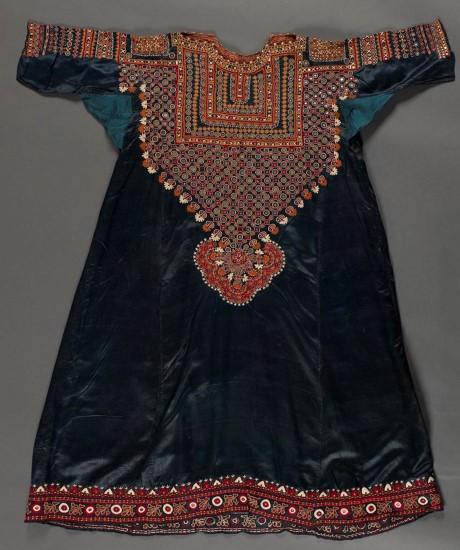Aatchala,
Term in Kantha embroidery, Bengal. With eight triangles or segments; term derived from aatchala, meaning eight-roofed. Chala refers to the sloping roofs of huts. Thus a roof can be dochala - with two segments, or charchala with four segments.
Term in Kantha embroidery, Bengal. With eight triangles or segments; term derived from aatchala, meaning eight-roofed. Chala refers to the sloping roofs of huts. Thus a roof can be dochala - with two segments, or charchala with four segments.
Abocchnai,
A wedding shawl, embroidered in silk or cotton with motifs of flowering bushes on a red, white or brown cotton ground by the Dars and Pali landowners and the Lohana and Memon merchant castes in Thar Parkar, Sind. Examples of these shawls can also be found in Banni Kutch.
A wedding shawl, embroidered in silk or cotton with motifs of flowering bushes on a red, white or brown cotton ground by the Dars and Pali landowners and the Lohana and Memon merchant castes in Thar Parkar, Sind. Examples of these shawls can also be found in Banni Kutch.
Abrawan,
Mixed brocade fabric of silk and muslin with some portions designed with gold or silver thread, woven in Uttar Pradesh.
Mixed brocade fabric of silk and muslin with some portions designed with gold or silver thread, woven in Uttar Pradesh.
Abstract,
Style of art in which shapes, designs, textures, and colors are presented in a way that may look unrealistic but that emphasizes moods or feelings. Abstract art is characterized by the use of geometric lines and shapes and bold, bright colors.
Style of art in which shapes, designs, textures, and colors are presented in a way that may look unrealistic but that emphasizes moods or feelings. Abstract art is characterized by the use of geometric lines and shapes and bold, bright colors.
Access and Benefit-sharing,
The Convention on Biological Diversity (1992) prescribes “the fair and equitable sharing of the benefits arising out of the utilization of genetic resources, including by appropriate access to genetic resources and by appropriate transfer of relevant technologies, taking into account all rights over those resources and to technologies, and by appropriate funding.” (Article 1). The Nagoya Protocol on Access to Genetic Resources and the Fair and Equitable Sharing of Benefits Arising from their Utilization to the Convention on Biological Diversity (2010) aims to “the fair and equitable sharing of the benefits arising from the utilization of genetic resources, including by appropriate access to genetic resources and by appropriate transfer of relevant technologies, taking into account all rights over those resources and to technologies, and by appropriate funding, thereby contributing to the conservation of biological diversity and the sustainable use of its components.” According to Article 3, the Protocol “shall also apply to traditional knowledge associated with genetic resources within the scope of the Convention and to the benefits arising from the utilization of such knowledge.”
The Convention on Biological Diversity (1992) prescribes “the fair and equitable sharing of the benefits arising out of the utilization of genetic resources, including by appropriate access to genetic resources and by appropriate transfer of relevant technologies, taking into account all rights over those resources and to technologies, and by appropriate funding.” (Article 1). The Nagoya Protocol on Access to Genetic Resources and the Fair and Equitable Sharing of Benefits Arising from their Utilization to the Convention on Biological Diversity (2010) aims to “the fair and equitable sharing of the benefits arising from the utilization of genetic resources, including by appropriate access to genetic resources and by appropriate transfer of relevant technologies, taking into account all rights over those resources and to technologies, and by appropriate funding, thereby contributing to the conservation of biological diversity and the sustainable use of its components.” According to Article 3, the Protocol “shall also apply to traditional knowledge associated with genetic resources within the scope of the Convention and to the benefits arising from the utilization of such knowledge.”
Acetic Acid,
An organic acid widely used while printing and dyeing. Vinegar is a dilute Acetic Acid.
An organic acid widely used while printing and dyeing. Vinegar is a dilute Acetic Acid.
Achmani,
A ritual spoon of brass, copper, or five-metals often made with great ornamentation. It consists of a circular bowl- usually a plain hemisphere or an ornate flower-cup- to which a long handle is attached. The handle is often in the form of Vishnu, Kaliya damana Krishna, Hanuman, entwined snakes, or a multi hooded cobra. These spoons were used in household and temple rituals for symbolic purification with sacred water by transferring ritual water from one container to the other, or for sprinkling water in various directions, or for pouring ghee into the lamp, or sacrificial fire or for drinking ritual water as prasada for the grace of god.
A ritual spoon of brass, copper, or five-metals often made with great ornamentation. It consists of a circular bowl- usually a plain hemisphere or an ornate flower-cup- to which a long handle is attached. The handle is often in the form of Vishnu, Kaliya damana Krishna, Hanuman, entwined snakes, or a multi hooded cobra. These spoons were used in household and temple rituals for symbolic purification with sacred water by transferring ritual water from one container to the other, or for sprinkling water in various directions, or for pouring ghee into the lamp, or sacrificial fire or for drinking ritual water as prasada for the grace of god.
Acid,
A chemical compound, with a sour taste, that releases hydrogen ions when dissolved in water. The strength of the acid depends upon the concentration of hydrogen ions. Acids react with bases, forming salts. Acids have a pH less than 7. Acids can be organic - such as critic, tartaric, tannic, oleic and acetic - and inorganic or mineral - such as sulphuric, hydrochloric, nitric, and phosphoric.
A chemical compound, with a sour taste, that releases hydrogen ions when dissolved in water. The strength of the acid depends upon the concentration of hydrogen ions. Acids react with bases, forming salts. Acids have a pH less than 7. Acids can be organic - such as critic, tartaric, tannic, oleic and acetic - and inorganic or mineral - such as sulphuric, hydrochloric, nitric, and phosphoric.
Adaptation,
Adaptation is the act of altering a pre-existing work (either protected or in the public domain) or a traditional cultural expression, for a purpose other than for which it originally served, in a way that a new work comes into being, in which the elements of the pre-existing work and the new elements—added as a result of the alteration—merge together. Article 12 of the Berne Convention for the Protection of Literary and Artistic Works (1971) provides that authors of literary and artistic works shall enjoy the exclusive right of authorizing adaptations, arrangements and other alterations of their works. Black’s Law Dictionary provides that copyright holders have the exclusive right to prepare derivative works, or adaptations, based on the protected work.
Adaptation is the act of altering a pre-existing work (either protected or in the public domain) or a traditional cultural expression, for a purpose other than for which it originally served, in a way that a new work comes into being, in which the elements of the pre-existing work and the new elements—added as a result of the alteration—merge together. Article 12 of the Berne Convention for the Protection of Literary and Artistic Works (1971) provides that authors of literary and artistic works shall enjoy the exclusive right of authorizing adaptations, arrangements and other alterations of their works. Black’s Law Dictionary provides that copyright holders have the exclusive right to prepare derivative works, or adaptations, based on the protected work.









